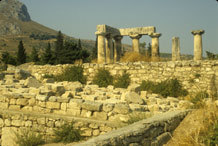
How does one go about restoring an ancient Greek temple with nothing still standing, no foundation and most of it missing?
You just have to have tons of time in which to design a building that makes reasonable use of every fragment of every block and tile that remains,said University of Notre Dame art historian Robin Rhodes.
And that is precisely how Rhodes has managed to reconstruct the first truly monumental temple in Greece, which around 675 B.C. was built on Temple Hill in the center of Corinth, and was destroyed about 100 years later.The project ultimately will yield a history of Greek architecture in Corinth, as well as an understanding of the origins of temple building in ancient Greece.
An associate professor in Notre Dames Department of Art, Art History and Design and concurrent in the Department of Classics, Rhodes has worked in Greece for some 30 years.He came to Notre Dame in 1996 and three years later, through the American School of Classical Studies in Athens, launched the Project for the Study and Publication of Greek Stone Architecture at Corinth.
As principal investigator of the Greek Stone Architecture at the Corinth Excavations and director of the Corinth Architecture Project, his first task was reconstructing the temple on paper, which, because of its extremely fragmentary nature and unprecedented form, had never been done.
There are more than 400 fragmentary blocks and hundreds of fragmentary tiles (the temple was the first with a terracotta tiled roof), and it takes a long time to measure and draw them all,Rhodes said.After the temple was destroyed, and when they acquired the means to build a successor, they pushed the debris off the temple site and dumped it into a deep road bed which, essentially, became a time capsule.

Over the years, some 20 Notre Dame undergraduate and graduate students of classics, art history, classical archaeology, architecture, sculpture, ceramics, printmaking, graphic design and industrial design have worked with Rhodes on the Corinth excavations.
The team spent years turning, examining, grouping and drawing each of the tiles and blocks, the largest of which weigh some 200 pounds.With only about 20 percent of the original temple material preserved, Rhodes had to rely on clues of shape and cuttings in the fragments, as well as statistics, to complete the reconstruction.
Field work on the project was completed over six years, and in 2006 Rhodes brought the first exhibit of the reconstructed temple to Notre Dames Snite Museum of Art.The display featured a computerized depiction of the reconstruction process, models of the stones and tiles, full-scale replicas of portions of the temple and a small-scale replica of the entire temple set within a diorama of video projections of the surrounding Greek landscape.
There has never been an exhibition of Greek architecture like this,Rhodes said.And its only appeared at Notre Dame, although weve had requests from other universities and have completed preparing the exhibition for travel.
Currently, Rhodes is putting the finishing touches on a catalog and DVD of the exhibition, as well as a monograph on the temple, and, after several more years of field work, he intends to write a synthetic history of the architecture of Corinth.
Because the architecture and, of course, the literature of Athens is so well preserved, our whole concept of Greek architecture and culture is completely Athenocentric,Rhodes said.And places like Corinth, that were really vital, rich and important, have been overlooked.A history of the Greek architecture of Corinth has never been written, and thats our goal for the second phase of the Corinth Project, which begins this spring.
This is a top initiative in scholarly research,said Gretchen Reydams-Schils, associate dean for research, graduate studies and centers in Notre Dames College of Arts and Letters.It unearths for us, literally, the very origins of temple building in ancient Greece, hence, through the study of material cultural remains, the delineation of sacred space in Western culture.
Rhodes notes the deeply interdisciplinary, collaborative nature of both the Corinth field project and the creation of the exhibition, whose staff included Notre Dame students and faculty in numerous disciplines.Also, as a result, two international conferences recently were held at Notre Dame on architectural reconstruction and the acquisition and exhibition of classical antiquities.
The project, which recently received a multi-year grant from the National Endowment for the Humanities, also is supported, among others, by Notre Dames Institute for Scholarship in the Liberal Arts, Arts and Letters, Office of Research, Office of the Provost, and Graduate School.
Additional information about the project is available at http://www.nd.edu/~corinth/ .
TopicID: 27448